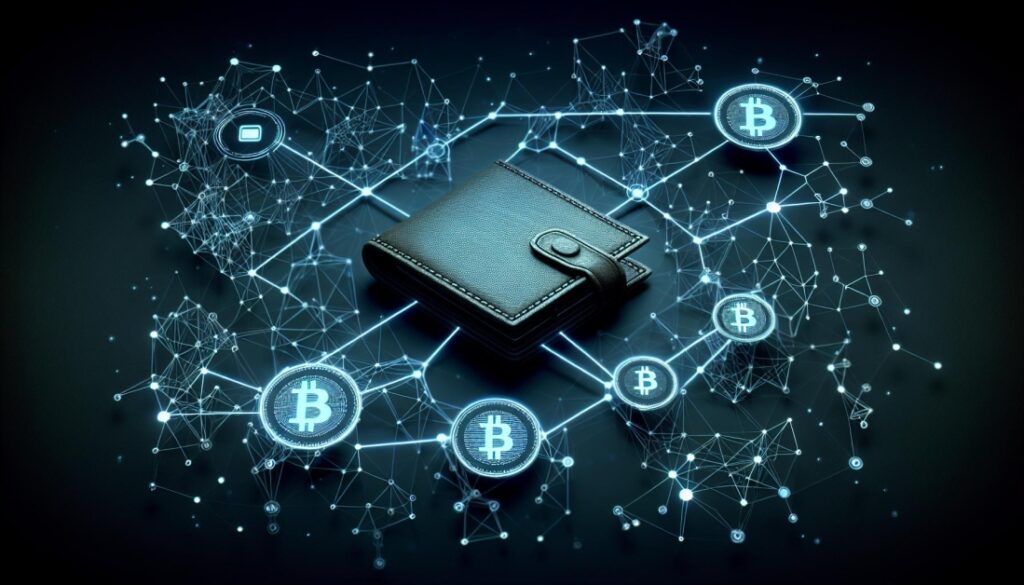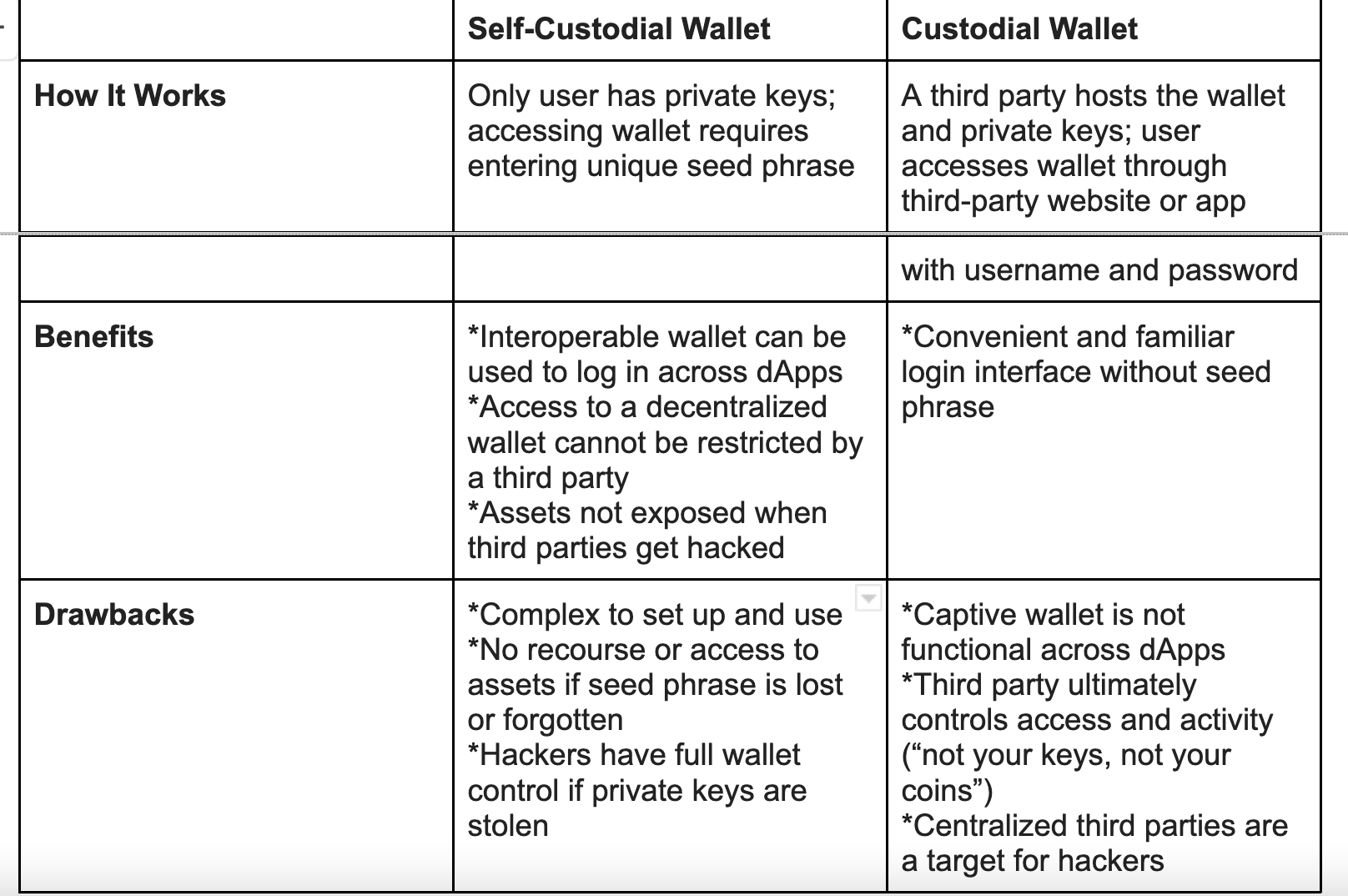Towards A Wallet-Free Web3

Blockchain wallets are a key component of Web3. Web3 wallets are essential for user identification and allow users to own data, permissions and apps.
The steep learning curve combined with the high risk of errors has been a barrier to mass adoption of Web3.
Users are engaged in depot and self-management wallets. Third-party managed depot wallets offer fewer features and less control for the user. Self-custodial wallets, on the other hand, give users control but require a lot of effort to set up and use. Self-custodial wallets require users to memorize and protect a 12 or 24 word phrase to prevent losing their wallet.
The “wallet bar” has hampered the onboarding of consumers and brands that would otherwise be drawn to Web3. Web3 will only be embraced by the masses if wallets are redesigned in such a way that users hardly know they exist. This is similar to the way Web2 apps don’t expose the user’s UserId to an internal database. Web3 user activities should be decentralized and secure. It should also be easy to manage without requiring seed phrases.
This future is already being built on a handful of new and convergent technologies. In the coming years, the ubiquity of wallets will recede into the background. Web3 then offers seamless integration and easy onboarding across platforms.
The wallet barrier
In the early days of Web3, dApps required a wallet. This can either be self-managed or hosted by an external custodian. Although hybrid wallets have been developed, most users are faced with two inferior options that come with significant drawbacks in terms of convenience, security, and access.

Self-serving wallets are often required to use certain dApps. This includes many crypto trading platforms and NFT marketplaces. Setting up a seed phrase and wallet can be intimidating and confusing for those unfamiliar with Web3. This in turn leads to potential users abandoning the onboarding process.
Self-serving wallet management comes with many challenges and inconveniences, even if the initial setup is successful:
-
How to remember and protect a seed phrase
-
Tracking a numbers-only account
-
Deciding whether to do so should happen or not Sign transactions that are often difficult to understand
-
Connect to blockchains and dApps
-
Find entry and exit points for fiat currencies
-
Tokens are used to cover (gas) transaction fees the right type and quantity needed
-
In an environment where hackers are diverse and phishing attacks are common, it is important to have the right security measures in place.
Web2 also has problems with account management. Users either juggle a growing list of logins or passwords for hackers to exploit and/or use centralized password managers that have been the target of successful cyberattacks. While Web2 offers convenience, it comes at the cost of privacy and user control.
Converging Solutions
Innovative technologies offer new ways to overcome both the account management problems in Web2 and the wallet barrier of early Web3.
These technologies are having a dramatic impact on the user experience when interacting with dApps running on blockchains. At the same time, new approaches to identity verification and interoperability make signing into apps and services easier and more convenient. The connection of these technologies will help to take a backseat to wallets and improve functionality and security for users.
These new technologies, while still in the early stages, will soon break through the wallet barrier and allow smooth and hassle-free integration and integration into Web3.
Smart Contract Wallets
Smart Contract Wallets work on the blockchain and are programmable. Smart contract wallets are one way to interact with blockchains. They are programmable and come with a variety of features that standard wallets don’t offer.
-
Simplified Transactions Smart contract wallets enable key features such as bundling transactions, paying for gas with different tokens, and allowing brands or dApps to pay transaction fees on a user’s behalf.
-
Private Key Recovery: These wallets allow users to set up systems that give them access in case their seed phrase is lost or forgotten. For example, Social Recovery backs up segments of a private key and shares them with trusted family members or friends who can authorize key recovery.
-
Smart contract wallets offer users the ability to set up rules that protect them from theft. For example, you can limit spending, set transaction limits, or create a list of addresses you are allowed to interact with to avoid being tricked by fake sites. Smart contract wallets also allow users to preview the results of a transaction before executing it.
Smart contract wallets are the building blocks of a robust Web3 that avoids both the pitfalls and risks associated with self-custodial or custodial wallets. You can automate and simplify transactions across dApps, making Web3 more accessible to non-power users as well. Smart contract wallets eliminate a major Web3 onboarding problem by providing private key recovery tools. Smart contract wallets are still not widespread, but their use is growing on Layer 2 blockchains running on Ethereum, enabling cheaper and faster transactions.
Smart contract wallets can be programmed to validate users based on flexible and customizable criteria. Users can now manage smart wallets through more familiar and user-friendly accounts. This could decouple user accounts from wallets that initiate transactions. In the following sections, we’ll look at some new identity mechanisms that might be useful for this purpose.
Decentralized identifiers
Decentralized identifiers allow verification of identification information while the data remains under the user’s cryptographic lock and key control. DIDs are a reliable ID for almost any piece of information. They can be authenticated by a cryptographic signature.
How do DIDs contribute to a Web3 that is “walletless”?
Smart contracts and DID validation can make the Web3 wallet concept obsolete. Smart contracts can be used to require the user’s DID as verification for transactions instead of a wallet address. Users can initiate and authenticate transactions through a simple interface if required. This eliminates the need for a confusing or lengthy sequence of steps. Gas fees can either be paid by dApps (especially on Layer 2 blockchains with their low gas fees) or aggregated into a price that users can authorize with one click.
Worldcoin
Worldcoin’s World ID technology is an example of how DIDs are used to verify digital identity. World ID cards can be compared to a passport, in which various stamps confirm certain information such as age or address or even work or education history. Users can show a stamp if needed without having to reveal the entire passport.
Credentials are configured to only share information with those who need it. For example, an ID card could prove that a person has reached the age of 21 without having to state their actual age. Credentials are also used to authenticate that an individual has taken certain actions, such as voting or making a donation.
Jeff Wilser: Inside the Orb: The Untold Story of Worldcoin’s Launch
DIDs are a way to verify your identity without having to use a seed phrase. By programming a smart contract that recognizes an authenticated DID, users can securely access and interact with dApps as these technologies evolve.
Worldcoin and Okta have partnered to develop a World ID that can be used to log into a variety of apps. World ID controls authorization using biometrics and/or smartphone (iris scanning). This helps prevent fraud. Worldcoin may not become the preferred DID, but its technology can improve the way users interact with blockchains.
Bluesky
Bluesky is a social blogging app based on the AT protocol. This social network framework prioritizes decentralization so users can have privacy, control, and portability over their data. The AT protocol allows a single account to interoperate with various decentralized social networks without the need for seed phrases or separate logins.
DIDs are used to authenticate public usernames and handles in the AT protocol. Bluesky stores user data in encrypted data repositories associated with a specific user’s DID. Users can migrate their data and social connections to another social network if they decide to leave Bluesky.
Despite being an invitation-only Bluesky, it has been downloaded over 1 million times. This reflects the popularity of this new social web model. Bluesky is not based on blockchains but on the AT protocol and shows how new technologies allow users to have a single account across multiple apps while maintaining decentralization, privacy and security.
Google Passkey
Google Passkey allows users to access their Google accounts and other online services without having to enter a password. A cryptographic key is stored on a phone, laptop, or in the cloud. When logging in, the public key must be authenticated. This can be achieved by unlocking a connected phone or laptop using fingerprint or face recognition.
The passkey can be used to access accounts instead of usernames and passwords, reducing the attack surface for hackers. Smart contracts can be programmed to verify user identity by storing the public key in the contract. This would allow only the owner of the passkey to authorize transactions with the blockchain. This would allow non-technical people to interact with dApps in a secure and intuitive way, without the need for seed phrases or passwords.
The long-term development of Passkey by Google, Apple and Microsoft has ensured that this technology is widely used by online services and users. While including these companies in the Passkey synchronization process seems at odds with the blockchain’s decentralization philosophy, many users might find the convenience and familiarity of the security mechanisms worthwhile.
Token-bound accounts
Token-bound accounts allow any non-fungible (NFT) token to hold assets like other tokens or cryptocurrencies, allowing the NFT to work like a wallet. Tokens are held directly in the NFT. If the NFT changes hands, the assets attached to it will also be transferred.
Although detailed use cases have yet to be developed, tokenized accounts demonstrate the flexibility and diversity of resources on the chain. A tokenized account allows users to subdivide decentralized assets. However, the assets can always be controlled and managed by the person whose credentials are used to prove ownership.
Unlock Web3 without wallet
The wallet will become less important in Web3 onboarding as smart contract wallets and DIDs mature.
In a world where Web3 has been adopted by millions, there is no need for the average Web3 user to think about wallets or blockchains. Web2 is based on databases that users access through a familiar method such as their email address or social media account. Still, users seem neither concerned nor aware of the mechanisms behind the database and the login process.
The same applies to wallets and blockchains, which can be used to activate dApps, but then disappear in the background. This allows users to access important functions that are crucial for general usage.
-
Sign in using familiar methods backed by robust security
-
Ownership: Users can control and own their blockchain-based account to protect their privacy. However, dApps can send assets or rewards directly to these accounts.
-
Interoperability: Users can easily manage their assets through an open ecosystem that includes tokenized software.
It’s possible that a small group of users will continue to manage their wallets, but the majority of Web3 users don’t want or need to micromanage thousands of high-value crypto transactions. We need to simplify the UX and remove the wallet barrier to make Web3 applications like loyalty programs more attractive.
For example, brands can build loyalty programs on the blockchain to offer their customers interoperable memberships and powerful rewards, while leveraging smart contract wallets that cover transaction costs upon sign-up. Brands benefit from a growing and innovative loyalty program, while users benefit by receiving benefits without knowing they are interacting with the blockchain.
For example, Nike could reward a customer by sending a virtual shoe to an account known to them. With the same account, users can wear the shoe in the metaverse of their choice, get a discount or event, or even sell it on an OpenSea-like market. And all without having to manage a wallet. This is just a small sample of the diverse, user-empowering experiences Web3 can enable.
In order for Web3 to go mainstream, wallets need to be as invisible as databases in Web2. Converging technology allows wallets to be pushed to the background, making Web3 more accessible and convenient. Using these technologies, Web3 can reach a mass audience and enter a new era.





